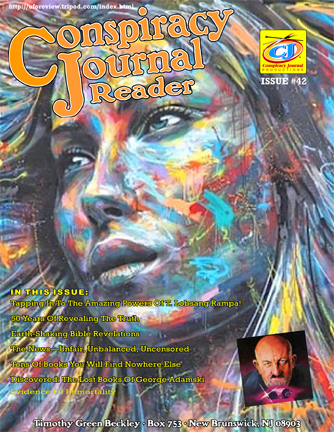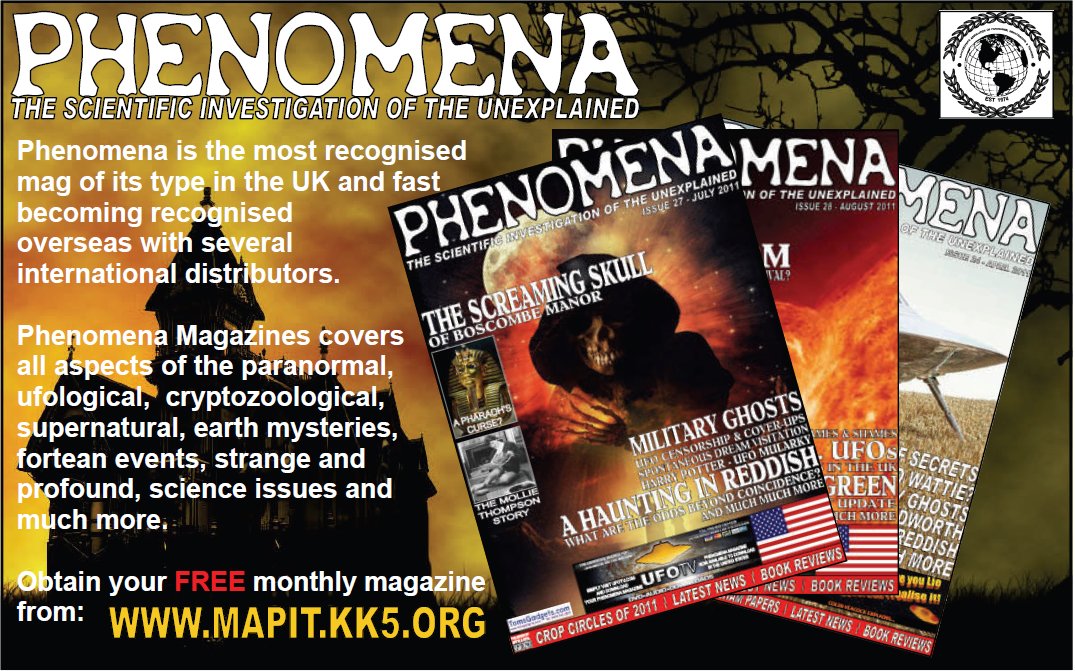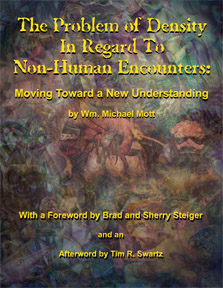- THE LAKE WORTH MONSTER DEPARTMENT -
Greer Island’s Goatman
By Charles Scudder
Greer Island’s Goatman
By Charles Scudder

Something monstrous is lurking among the singing cicadas and rustling reeds on the shoreline of the West Fork of the Trinity River.
First spotted 45 years ago this month, the creature has been known to throw tires and scare teenagers.
Real or imagined, the thing appeared to be “part man and part goat” with scales and long clawed fingers, witnesses claimed. It made the pages of the daily newspapers and whipped Tarrant County into a monster-hunting frenzy in the summer of 1969.
They called it the “Lake Worth Monster.”
Even today, stories of the monster, also known as “Goatman,” can be heard around campfires in North Texas. Researchers have made documentaries and written books. Lakewood Brewing Co. even decided to pay respect with a limited-release Goatman beer.
“The stories are enduring. The lore is enduring,” said Michelle Villafranca, a natural resource specialist at the Fort Worth Nature Center and Refuge.
Villafranca organizes a Lake Worth Monster Bash at the nature center in October to celebrate the monster (this year’s bash is scheduled for Oct. 4). Along with being in charge of land management at the park, she’s become the go-to collector of all things monstrous.
On the windowsill of her office is an empty bottle of Sierra Nevada Bigfoot Ale. She has a book written about the Lake Worth Monster filed on her bookshelf right next to her field guides of local mammals.
“We have alligator sighting report forms; we don’t have any Goatman sighting forms. Maybe we should start,” Villafranca said. “After all, he is North Central Texas fauna.”
Summer of ’69
The summer of 1969 was hot and humid in Tarrant County.
Back then, the area near Greer Island wasn’t gated off like it is now. Teenagers would go down Shoreline Road around the lake to be alone and enjoy the freedom of summer nights.
On July 9, a group of three couples was parked by a clearing. Around midnight, a beast leapt onto their car from the trees above. The monster tried to grab one woman, but they sped off before it could take her away, the witnesses said.
“We’ve had reports about this thing for about two months,” a police dispatcher told the Fort Worth Star-Telegram, “but we’ve always laughed them off as pranks.”
But an 18-inch gash in the car’s side and the terrified nature of the witnesses led police to open a full investigation. It appeared in the newspapers the next day, and the area was immediately caught in monster-fever.
Truckloads of men with guns headed toward Greer Island to hunt the thing. Spectators came out in droves to try to catch a glimpse of it. Reporters swarmed in, and police tried to keep the peace.
Rick Pratt, director of the Greer Island Nature Center at the time, remembers folks coming out with wine, whiskey and beer to have a good time and hunt for the creature.
“Here was a Sasquatch, our very own,” Pratt said. “It was a party, what the hell, let’s go.”
On the night of July 10, a few dozen people were at a clearing known for dumping near the lake when the monster made another appearance. It appeared on a cliff, looked angry, and threw a tire 500 feet. Everyone, including a group of sheriff’s deputies, ran away in fear.
One witness said the monster gave off a “pitiful cry, like something was hurting him.”
Craig Woolheater was 9 that summer. He was fascinated with monsters, dinosaurs and UFOs. He clipped out the newspaper stories about the Lake Worth Monster scare and kept them in a scrapbook.
Years later, while driving through Louisiana, he saw something unexplainable. In his headlights, he said, he saw the gray body of a huge primate on two legs. He became a believer and started the Texas Bigfoot Research Center in 1999 to study and educate people about the elusive creature.
Today he lives in Mansfield and is a full-time cryptozoology blogger. He believes the Lake Worth Monster was a real creature, like ones that have been spotted all over the country, stopping in the area because of its viable habitat.
“I personally think it’s an undiscovered, uncataloged primate species that walks on two legs,” he said.
Reporter’s tale
The thing about myths and monsters is they are not easy to prove. But this next story is absolutely true.
It was the summer of 1999, when I was at Fort Worth’s Camp Carter, just down the Trinity River from Lake Worth. Once, we went into the woods in the late evening, trees casting long blue shadows as mosquitos nipped at our ankles and elbows.
We came to a clearing, where the camp counselors had made a small campfire. They told us about the legend of Goatman.
“Listen carefully,” they told us, wide-eyed with fear and amazement, “and you’ll hear his cry on clear nights like tonight.”
The older boys at the camp gave us easy explanations. It was just a way for the counselors to get us to finish our vegetables and not act up. It had to be the counselors making noises in the night.
We walked back to our cabin, sticky with the humid hot air. I knew the Goatman stories had to be just stories.
Yet as I lay down in my bunk that night, listening to the melody of the cicadas outside, I heard something unnatural: a mournful bleating echoing from far across the lake, unmistakable as the monster’s lone cry.
It sounded sad.
Source: The Dallas News
http://res.dallasnews.com/interactives/goatman/
- PAST LIFE MEMORIES DEPARTMENT -
Woman Starts Speaking in Past-Life Language
By Tara MacIsaac
Woman Starts Speaking in Past-Life Language
By Tara MacIsaac
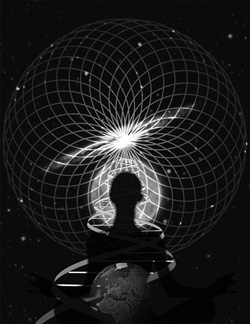
In the 1970s, famed reincarnation researcher Ian Stevenson encountered a woman who could fluently speak a form of Bengali spoken some 150 years earlier. Modern Bengali contains about 20 percent English loan words, Bengali Professor P. Pal told Stevenson. But this woman had long conversations with Professor Pal without using a single one. On the other hand, she used more Sanskrit words, just as Bengalis did around 1810 to 1830, the hypothesized time period of her past life.
She spoke completely fluently as though she were raised in Western Bengal, a region she had many memories of, though she had never been there in this life. She was born and raised in Nagpur, India, speaking Marathi, as well as a bit of Hindi and English.
When this woman, Uttara Huddar, was 32 years old, a new personality emerged calling itself Sharada. Huddar had not talked about remembering a past life before this point. She had a double M.A. degree in English and public administration and she was a part-time lecturer at Nagpur University until she started sharing her body with what could be called a discarnate woman.
Sharada, this new personality, could not speak or understand any of the languages Huddar could. Sharada didn’t recognize Huddar’s family or friends, and she was baffled by the many instruments invented after the Industrial Revolution. Huddar’s family didn’t know any Bengali and they were unfamiliar with the ethnic foods and other things Sharada desired.
Stevenson and his fellow researchers spent a couple of weeks investigating her story over the course of a couple years. They checked up on places she remembered in Bengal (some of them in modern-day Bangladesh). Her descriptions were accurate in terms of distance between places, geographical layout, et cetera.
She gave the full names of her family members, including her father’s name, Brajanath Chattopaydhaya. When Stevenson found a genaeology of a Chattopaydhaya family living in the region Sharada described as home, he discovered Sharada had correctly named and described her relationship with five of her family members, including her father and grandfather. These family members lived during the 19th century time frame Sharada’s accounts seemed to describe.
“The genealogy is exclusively a male one. Since no women’s names appear in it, we cannot say that we have proved that a person corresponding to Sharada’s statements existed. But the correspondence between the genealogy and her statements about the relationships of the male members of the family seems beyond coincidence,” Stevenson wrote in a paper published in The Journal of the American Society for Psychical Research in July 1980 titled “A Preliminary Report on an Unusual Case of the Reincarnation Type With Xenoglossy.” Xenoglossy refers to the ability to speak or write in a language unfamiliar to the speaker or writer.
As a child, Huddar had a strong phobia of snakes. Her mother said that, while pregnant with Huddar, she had dreamed repeatedly of being bitten on the foot by a snake.
Sharada recalled that she was seven months pregnant and was picking flowers when a snake bit her toe. She said she became unconscious, though she did not explicitly say she remembered dying. At the time, she was 22, and “she seemed to have no awareness that any time had elapsed,” Stevenson said.
Sharada would take over Huddar’s body for days or weeks at a time, and Huddar’s family started to notice that these periods corresponded to certain phases of the moon. Neither would remember the actions of the other, leading Stevenson to say it was perhaps more a case of possession than of reincarnation.
“The amnesia each personality appears to have had for events occurring to the other, even though it was not total, suggests the possession syndrome more than a case of the reincarnation type,” he wrote. ”This implies that Sharada is a discarnate personality—that is, that she consists of surviving aspects of a real person who lived and died in the early years of the 19th century, and who, almost 150 years later, came to dominate and control Uttara’s body.”
He continued: “Other details, however, are consistent with the interpretation of the case as one of reincarnation. First, Uttara had a phobia of snakes when she was a small child, and later, she showed a liking for Bengal and Bengalis.”
Her father was a Bengali enthusiast, because he felt the Bengalis did a better job protecting themselves from British forces and he was involved in the Indian nationalist movement. She may have inherited this interest in Bengal from him. She learned a few words of Bengali in a high school class (taught by someone who didn’t speak Bengali and who used the Marathi pronunciations). But, said Stevenson, there were no indications that she could have spent nearly enough time exposed to the Bengali language to become proficient in the language, let alone speak with the intonation and fluidity of a native speaker. The fact that the version of Bengali she spoke was also 150 years outdated provided compelling evidence, he said, along with her intimate knowledge of the food and culture.
Source: Epoch Times
http://www.theepochtimes.com/n3/811086-woman-speaks-foreign-language-without-learning-it-as-it-was-spoken-150-years-ago-past
-life-memories/
-
STRANGE
CREATURES FROM TIME AND SPACE DEPARTMENT -
The Bird That Devours Men
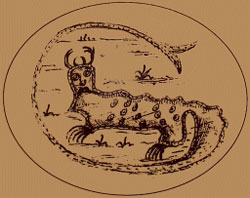
From the dark recesses of history comes a legend so amazing and terrifying, it’s astonishing that more people don’t know of its existence.
If you live in the St. Louis area, chances are you are familiar with the legend; or may have heard bits and pieces of it here and there. As historians and scientists dig deeper into this legend, more becomes known about a monster from the past that called the St. Louis region its home, and may still call it home today.
Upon exploring the Mississippi River in 1673, Louis Joliet and Father Jacques Marquette noticed the strange likeness of a creature painted and sculpted on the side of the bluffs. The creature was described as “a large creature with horns like a deer, red eyes, a beard like a tiger, a face like a man, body covered with green, red, and black scales and a tail so long it passed around the body, over the head, and between the legs.” The painting depicted a dark secret that, up until now, only the Illinois Indians had known.
Marquette and JolietThe Illini lived on the banks of the confluence of the Illinois and Mississippi Rivers, surrounded by forests and tall bluffs. The location is now home to the city of Alton, IL. The Chief of this village met with Joliet and Marquette and, when asked, reluctantly told the explorers the two hundred year old tale of the beast they now called the “Piasa Bird” which meant “bird that devours men”.
One night, several braves had returned to the village with a terrifying tale of a monstrous beast that had attacked their scouting party. They explained that the flying monster had swooped from the sky and picked up men and carried them off into the night. Their arrows had merely deflected off of its tough scales as they tried to defend themselves.
For several weeks the village suffered as the creature they were now calling “Piasa” attacked at night, carrying off a victim each time to an unseen fate. The Illini turned to their chief, Ouatoga, to rid them of this menace. After conversing with the Great Spirits, Ouatoga devised a plan. He believed that the creature would be vulnerable under its wings, where the scales did not protect. He had his warriors hide in the forest with poison-tipped arrows, while he offered himself as bait. The Piasa Bird appeared and went directly for the chief. He threw himself to the ground and held on to a tree root as the Piasa Bird tried to carry him off. Immediately, his warriors emerged and shot their arrows into the soft underbelly of the creature. In a scream of agony, it tumbled over the side of the bluffs and disappeared into the river.
Piasa Bird on the BluffsIn honor of this great victory, they painted the image of the Piasa Bird on the face of the bluffs. Believing that the Piasa Bird had lived in a large cave that was nearby, they warned all villagers to stay away from the cave, as they did not want to awaken any more of these evil spirits. In two hundred years, they had not encountered another menace like this.
Joliet and Marquette scoffed at this tale, attributing it to silly Indian folklore. However, they were both explorers who had spent a great deal of time discovering and documenting new species they encountered in their journeys west. Despite the chief’s warnings, they decided to explore the cave and see if they could find some evidence of this strange species.
They amassed a party of white settlers and an Illini scout named Pow-Ka-Ha-Toh (Sees in the Darkness) who was well known to the villagers as being able to see in the night as if it were daylight. They entered the cave and, armed with torches and muskets, began to work their way into the bluffs. As they explored deeper into the cave, they began to feel the crunch of bones underneath their feet. Further examination revealed them to be the bones of many different animals, some they even believed to be human remains.
Suddenly, a mist and wind swept through the cave, extinguishing their torches. In the darkness they began to hear loud shrieks and screams. Pow-Ka-Ha-Toh told Joliet that he saw many reptilian creatures, about the size of eagles, swarming towards them. Behind these creatures, he saw an enormous reptilian monster and declared it to be the “Piasa Bird”. The party fired a volley into the darkness from their muskets, and then fled towards the mouth of the cave. There was panic and confusion as the men struggled to reach the cave opening; meanwhile screams of men filled the air and were abruptly silenced. Joliet, Marquette, Pow-Ka-Ha-Toh, and one other settler were the only ones to make it out of the cave.
The Battle of PiasaThey returned to the village and Pow-Ka-Ha-Toh told the chief what had happened. The chief, angered that they had awakened the evil spirits, forced them to leave the village. Joliet and Marquette returned to the nearby French outpost of St. Louis and amassed an army of traders, soldiers, and able bodies to help them eliminate what they saw as a threat to trade and settlement opportunities in the region. When they returned to the village, they found it destroyed and deserted. They heard cries and screams in the distance.
A few minutes later, they noticed a dark mass approaching in the northern sky. Hundreds of winged creatures, followed by the enormous Piasa Bird, were descending upon them. The soldiers began firing their muskets, cannons, and ship-mounted artillery into the mass. The creatures began to fall from the sky as they were struck by the ordinance, but still on the mass of creatures came. The solders, with Joliet and Marquette at the lead, fought a pitched battle with the creatures as men and equipment were picked up and thrown about. Bodies were torn apart as the Piasa Bird and its minions swarmed the soldiers.
Slowly the soldiers began to drive the creatures back towards the bluff using torches and bonfires. The creatures appeared to fear the heat of the flames. Several other boats had arrived with more soldiers and weapons to reinforce the makeshift army and join the battle. Under Joliet’s direction, the soldiers fought to force the monsters towards the bluffs and back into the cave where they had discovered them. Joliet figured that he could trap the creatures inside the cave and then seal it shut. Once the creatures were driven back into the cave, fires were set all around the mouth of the cave to keep them at bay. Cannoneers came forward and blasted the cliff face with a volley of cannonballs, creating an avalanche of rock and debris, effectively sealing the cave.
Marquette Piasa Bird SketchUpon their return to St. Louis, Joliet and Marquette reported to the governor what had transpired. They agreed that the menace had surely been destroyed and, in the interest of protecting their profits and interests in this new land, decided to keep the story of the Piasa Bird and its kin quiet. Naturally, the story did not stay a secret long. Survivors of the battle spun their tales, and even Marquette’s own journal sported some illustrations of the beast he had first seen painted on the bluffs. Most settlers, however, believed it to be a tall tale, concocted by glory seeking soldiers and crazy Indians and felt no fear in venturing into the region. As years passed, settlers built settlements and outposts all along the river and built the city of Alton where the old Illini village had been. The Piasa Bird and its kin were never seen or reported again. The original painting on the rocks of the Piasa Bird was left there as an amusement for travelers, until it was destroyed during excavation of the bluffs.
Today, historians and scientists seek to unravel the mysteries surrounding these great and terrible creatures. They search to find the line of what is myth and what is reality. Were these creatures dinosaur-like leftovers from a prehistoric time? Were they a new species altogether? Were they large birds given incredible powers by the imaginations of the Indians and early settlers?
Historians find new clues and evidence all of the time, and soon we may know the truth. They have fought to keep the legend alive and have continued to keep a large painting of the Piasa Bird on the bluffs, as an homage to the brave warriors of the past, and in the hopes of new found evidence for the future. But as people turn up missing in the bluffs, and mysterious disappearances on the river mount every year; more people are beginning to believe that the “Piasa Bird”, or its descendants, still dwell in The Great River Bend.
Source: Failed Success
http://www.failedsuccess.com/index.php?/weblog/comments/piasa_bird_legend
- WHAT LIES BELOW DEPARTMENT -
What Happened to the Sunken City of Cuba?
By April Holloway
What Happened to the Sunken City of Cuba?
By April Holloway

Just over a decade ago, a team of explorers were working on an exploration and survey mission off the western coast of Cuba when their sonar equipment picked up a perplexing series of stone structures lying some 650 metres below the surface. The structures appeared completely analogous against the barren ‘desert’ of the ocean floor and seemed to show symmetrically organized stones reminiscent of an urban development. A media flurry soon ensued with news sites sporting headlines such as ‘Atlantis Discovered in Cuba’ and ‘Lost City of the Caribbean Found’. However, the finding also attracted the attention of the government, national museum, and national geographic, who all made promises to investigate the strange sonar images. Now, ten years on, the story has disappeared into obscurity. What ever happened to the sunken ‘ruins’ of Cuba? Were they ever fully investigated? And why has the media fallen silent on this unusual discovery?
The discovery was first made in 2001 when Pauline Zalitzki, a marine engineer, and her husband Paul Weinzweig, owners of a Canadian company called Advanced Digital Communications (ADC), were working on a survey mission in conjunction with the Cuban government off the tip of the Guanahacabibes Peninsula in the Pinar del Río Province of Cuba. ADC was one of four firms working in a joint venture with President Fidel Castro's government to explore Cuban waters, which hold hundreds of treasure-laden ships from the Spanish colonial era. The team was using advanced sonar equipment to scan a 2 square kilometre area of the sea floor when they noticed a series of symmetrical and geometric stone structures resembling an urban complex.
Upon studying the sonar images, Zalitzki observed what appeared to be unusual formations of smooth blocks, crests, and geometric shapes. Some of the blocks looked like they were built in pyramid shapes, others were circular.
In July 2001, they returned to the site with geologist Manuel Iturralde, senior researcher of Cuba's Natural History Museum, this time equipped with a Remotely Operated Vehicle to examine and film the structures. The images revealed large blocks of stone resembling hewn granite, measuring about 8 feet by 10 feet. Some blocks appeared deliberately stacked atop one another, others appeared isolated from the rest. Zalitzki said that the images appeared to reflect the ruins of a submerged city but was reluctant to draw any conclusions without further evidence.
“These are extremely peculiar structures, and they have captured our imagination,” said Iturralde, who has studied countless underwater formations. “But if I had to explain this geologically, I would have a hard time.”
Estimating that it would have taken 50,000 years for such structures to have sunken to the depth at which they were said to be found, Iturralde added "50,000 years ago there wasn't the architectural capacity in any of the cultures we know of to build complex buildings." A specialist in underwater archaeology at Florida State University added "It would be cool if they were right, but it would be real advanced for anything we would see in the New World for that time frame. The structures are out of time and out of place."
In the media storm that followed the announcement of the discovery, news sites were quick to draw parallels with the fabled lost city of Atlantis. However, Zelitsky and Weinzweig were unwilling to make such comparisons. The story is myth, said Zelitsky. "What we have found is more likely remnants of a local culture," once located on a 100-mile "land bridge" that joined Mexico's Yucatan Peninsula with Cuba. Iturralde added that there are local legends of the Maya and native Yucatecos that tell of an island inhabited by their ancestors that vanished beneath the waves. Nevertheless, Iturralde does not discount the possibility that the rock formations are merely the result of the wonders of Mother Nature. “Nature is able to create some really unimaginable structures,” he said.
Despite hundreds of media outlets reporting on sunken cities, advanced civilizations, the lost city of Atlantis, and submerged ruins, there are others who are not so willing to accept this point of view. Keith Fitzpatrick-Matthews from the debunking website Bad Archaeology, claimed that the depth of the alleged remains are the biggest problem for the sunken city proponents. During the Pleistocene, which was characterised by a series of ice ages, sea levels dropped significantly, but the maximum drop was around 100 metres.
“At no point during the Ice Age would it have been above sea level unless, of course, the land on which they stand has sunk. This is the claim made for Atlantis: according to Plato’s account, it was destroyed “by violent earthquakes and floods”. However, if we take Plato at his word – as we must if we assume Atlantis to have been an historical place – the violence of its sinking makes it improbable that an entire city could have survived plunging more than 600 m into an abyss,” writes Fitzpatrick-Matthews.
If we assume that he is right and that these stone structures do not reflect an ancient submerged city but are simply products of nature, then surely geologists and other scientists would be quick to jump on the finding and investigate what freakish event of nature caused such peculiar formations. Strangely, however, there have been no reported follow-up investigations and news outlets have gone deathly silent on the matter. What happened to all the promises from the government, national museum, National Geographic, and other scientists to carry out further surveys?
The quick dismissal of the story has led some to question whether there has been a suppression of information regarding the finding. However, Fitzpatrick-Matthews claims the story simply went cold and that in the end experts were not convinced that Zelitsky had really discovered a sunken city.
Source: Ancient Origins
http://www.ancient-origins.net/ancient-places-americas/what-happened-sunken-city-cuba-001883#!bnXEvq
Sign
up today for Bizarre Bazaar and Conspiracy
Journal Magazines


